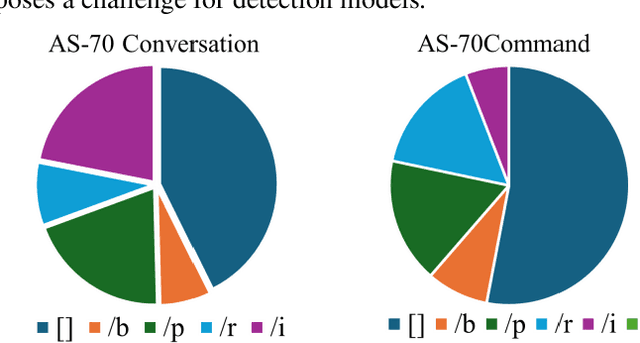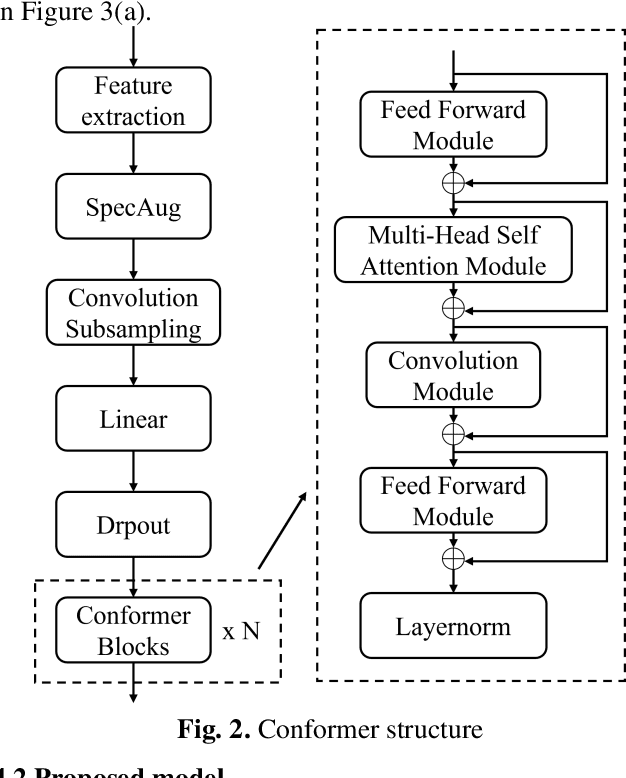Yudong Yang
ACVUBench: Audio-Centric Video Understanding Benchmark
Mar 25, 2025Abstract:Audio often serves as an auxiliary modality in video understanding tasks of audio-visual large language models (LLMs), merely assisting in the comprehension of visual information. However, a thorough understanding of videos significantly depends on auditory information, as audio offers critical context, emotional cues, and semantic meaning that visual data alone often lacks. This paper proposes an audio-centric video understanding benchmark (ACVUBench) to evaluate the video comprehension capabilities of multimodal LLMs with a particular focus on auditory information. Specifically, ACVUBench incorporates 2,662 videos spanning 18 different domains with rich auditory information, together with over 13k high-quality human annotated or validated question-answer pairs. Moreover, ACVUBench introduces a suite of carefully designed audio-centric tasks, holistically testing the understanding of both audio content and audio-visual interactions in videos. A thorough evaluation across a diverse range of open-source and proprietary multimodal LLMs is performed, followed by the analyses of deficiencies in audio-visual LLMs. Demos are available at https://github.com/lark-png/ACVUBench.
Improving LLM Video Understanding with 16 Frames Per Second
Mar 18, 2025Abstract:Human vision is dynamic and continuous. However, in video understanding with multimodal large language models (LLMs), existing methods primarily rely on static features extracted from images sampled at a fixed low frame rate of frame-per-second (FPS) $\leqslant$2, leading to critical visual information loss. In this paper, we introduce F-16, the first multimodal LLM designed for high-frame-rate video understanding. By increasing the frame rate to 16 FPS and compressing visual tokens within each 1-second clip, F-16 efficiently captures dynamic visual features while preserving key semantic information. Experimental results demonstrate that higher frame rates considerably enhance video understanding across multiple benchmarks, providing a new approach to improving video LLMs beyond scaling model size or training data. F-16 achieves state-of-the-art performance among 7-billion-parameter video LLMs on both general and fine-grained video understanding benchmarks, such as Video-MME and TemporalBench. Furthermore, F-16 excels in complex spatiotemporal tasks, including high-speed sports analysis (\textit{e.g.}, basketball, football, gymnastics, and diving), outperforming SOTA proprietary visual models like GPT-4o and Gemini-1.5-pro. Additionally, we introduce a novel decoding method for F-16 that enables highly efficient low-frame-rate inference without requiring model retraining. Upon acceptance, we will release the source code, model checkpoints, and data.
video-SALMONN-o1: Reasoning-enhanced Audio-visual Large Language Model
Feb 17, 2025Abstract:While recent advancements in reasoning optimization have significantly enhanced the capabilities of large language models (LLMs), existing efforts to improve reasoning have been limited to solving mathematical problems and focusing on visual graphical inputs, neglecting broader applications in general video understanding.This paper proposes video-SALMONN-o1, the first open-source reasoning-enhanced audio-visual LLM designed for general video understanding tasks. To enhance its reasoning abilities, we develop a reasoning-intensive dataset featuring challenging audio-visual questions with step-by-step solutions. We also propose process direct preference optimization (pDPO), which leverages contrastive step selection to achieve efficient step-level reward modelling tailored for multimodal inputs. Additionally, we introduce RivaBench, the first reasoning-intensive video understanding benchmark, featuring over 4,000 high-quality, expert-curated question-answer pairs across scenarios such as standup comedy, academic presentations, and synthetic video detection. video-SALMONN-o1 achieves 3-8% accuracy improvements over the LLaVA-OneVision baseline across different video reasoning benchmarks. Besides, pDPO achieves 6-8% improvements compared to the supervised fine-tuning model on RivaBench. Enhanced reasoning enables video-SALMONN-o1 zero-shot synthetic video detection capabilities.
An End-To-End Stuttering Detection Method Based On Conformer And BILSTM
Nov 14, 2024



Abstract:Stuttering is a neurodevelopmental speech disorder characterized by common speech symptoms such as pauses, exclamations, repetition, and prolongation. Speech-language pathologists typically assess the type and severity of stuttering by observing these symptoms. Many effective end-to-end methods exist for stuttering detection, but a commonly overlooked challenge is the uncertain relationship between tasks involved in this process. Using a suitable multi-task strategy could improve stuttering detection performance. This paper presents a novel stuttering event detection model designed to help speech-language pathologists assess both the type and severity of stuttering. First, the Conformer model extracts acoustic features from stuttered speech, followed by a Long Short-Term Memory (LSTM) network to capture contextual information. Finally, we explore multi-task learning for stuttering and propose an effective multi-task strategy. Experimental results show that our model outperforms current state-of-the-art methods for stuttering detection. In the SLT 2024 Stuttering Speech Challenge based on the AS-70 dataset [1], our model improved the mean F1 score by 24.8% compared to the baseline method and achieved first place. On this basis, we conducted relevant extensive experiments on LSTM and multi-task learning strategies respectively. The results show that our proposed method improved the mean F1 score by 39.8% compared to the baseline method.
Enhancing Multimodal LLM for Detailed and Accurate Video Captioning using Multi-Round Preference Optimization
Oct 09, 2024



Abstract:Videos contain a wealth of information, and generating detailed and accurate descriptions in natural language is a key aspect of video understanding. In this paper, we present video-SALMONN 2, an advanced audio-visual large language model (LLM) with low-rank adaptation (LoRA) designed for enhanced video (with paired audio) captioning through directed preference optimization (DPO). We propose new metrics to evaluate the completeness and accuracy of video descriptions, which are optimized using DPO. To further improve training, we introduce a novel multi-round DPO (mrDPO) approach, which involves periodically updating the DPO reference model, merging and re-initializing the LoRA module as a proxy for parameter updates after each training round (1,000 steps), and incorporating guidance from ground-truth video captions to stabilize the process. To address potential catastrophic forgetting of non-captioning abilities due to mrDPO, we propose rebirth tuning, which finetunes the pre-DPO LLM by using the captions generated by the mrDPO-trained model as supervised labels. Experiments show that mrDPO significantly enhances video-SALMONN 2's captioning accuracy, reducing global and local error rates by 40\% and 20\%, respectively, while decreasing the repetition rate by 35\%. The final video-SALMONN 2 model, with just 7 billion parameters, surpasses leading models such as GPT-4o and Gemini-1.5-Pro in video captioning tasks, while maintaining competitive performance to the state-of-the-art on widely used video question-answering benchmark among models of similar size. Upon acceptance, we will release the code, model checkpoints, and training and test data. Demos are available at \href{https://video-salmonn-2.github.io}{https://video-salmonn-2.github.io}.
Enabling Auditory Large Language Models for Automatic Speech Quality Evaluation
Sep 25, 2024



Abstract:Speech quality assessment typically requires evaluating audio from multiple aspects, such as mean opinion score (MOS) and speaker similarity (SIM) etc., which can be challenging to cover using one small model designed for a single task. In this paper, we propose leveraging recently introduced auditory large language models (LLMs) for automatic speech quality assessment. By employing task-specific prompts, auditory LLMs are finetuned to predict MOS, SIM and A/B testing results, which are commonly used for evaluating text-to-speech systems. Additionally, the finetuned auditory LLM is able to generate natural language descriptions assessing aspects like noisiness, distortion, discontinuity, and overall quality, providing more interpretable outputs. Extensive experiments have been performed on the NISQA, BVCC, SOMOS and VoxSim speech quality datasets, using open-source auditory LLMs such as SALMONN, Qwen-Audio, and Qwen2-Audio. For the natural language descriptions task, a commercial model Google Gemini 1.5 Pro is also evaluated. The results demonstrate that auditory LLMs achieve competitive performance compared to state-of-the-art task-specific small models in predicting MOS and SIM, while also delivering promising results in A/B testing and natural language descriptions. Our data processing scripts and finetuned model checkpoints will be released upon acceptance.
Extract and Diffuse: Latent Integration for Improved Diffusion-based Speech and Vocal Enhancement
Sep 15, 2024Abstract:Diffusion-based generative models have recently achieved remarkable results in speech and vocal enhancement due to their ability to model complex speech data distributions. While these models generalize well to unseen acoustic environments, they may not achieve the same level of fidelity as the discriminative models specifically trained to enhance particular acoustic conditions. In this paper, we propose Ex-Diff, a novel score-based diffusion model that integrates the latent representations produced by a discriminative model to improve speech and vocal enhancement, which combines the strengths of both generative and discriminative models. Experimental results on the widely used MUSDB dataset show relative improvements of 3.7% in SI-SDR and 10.0% in SI-SIR compared to the baseline diffusion model for speech and vocal enhancement tasks, respectively. Additionally, case studies are provided to further illustrate and analyze the complementary nature of generative and discriminative models in this context.
Exploring Knowledge Transfer in Evolutionary Many-task Optimization: A Complex Network Perspective
Jul 12, 2024Abstract:The field of evolutionary many-task optimization (EMaTO) is increasingly recognized for its ability to streamline the resolution of optimization challenges with repetitive characteristics, thereby conserving computational resources. This paper tackles the challenge of crafting efficient knowledge transfer mechanisms within EMaTO, a task complicated by the computational demands of individual task evaluations. We introduce a novel framework that employs a complex network to comprehensively analyze the dynamics of knowledge transfer between tasks within EMaTO. By extracting and scrutinizing the knowledge transfer network from existing EMaTO algorithms, we evaluate the influence of network modifications on overall algorithmic efficacy. Our findings indicate that these networks are diverse, displaying community-structured directed graph characteristics, with their network density adapting to different task sets. This research underscores the viability of integrating complex network concepts into EMaTO to refine knowledge transfer processes, paving the way for future advancements in the domain.
Automatic Assessment of Dysarthria Using Audio-visual Vowel Graph Attention Network
May 07, 2024Abstract:Automatic assessment of dysarthria remains a highly challenging task due to high variability in acoustic signals and the limited data. Currently, research on the automatic assessment of dysarthria primarily focuses on two approaches: one that utilizes expert features combined with machine learning, and the other that employs data-driven deep learning methods to extract representations. Research has demonstrated that expert features are effective in representing pathological characteristics, while deep learning methods excel at uncovering latent features. Therefore, integrating the advantages of expert features and deep learning to construct a neural network architecture based on expert knowledge may be beneficial for interpretability and assessment performance. In this context, the present paper proposes a vowel graph attention network based on audio-visual information, which effectively integrates the strengths of expert knowledges and deep learning. Firstly, various features were combined as inputs, including knowledge based acoustical features and deep learning based pre-trained representations. Secondly, the graph network structure based on vowel space theory was designed, allowing for a deep exploration of spatial correlations among vowels. Finally, visual information was incorporated into the model to further enhance its robustness and generalizability. The method exhibited superior performance in regression experiments targeting Frenchay scores compared to existing approaches.
An Audio-textual Diffusion Model For Converting Speech Signals Into Ultrasound Tongue Imaging Data
Mar 12, 2024Abstract:Acoustic-to-articulatory inversion (AAI) is to convert audio into articulator movements, such as ultrasound tongue imaging (UTI) data. An issue of existing AAI methods is only using the personalized acoustic information to derive the general patterns of tongue motions, and thus the quality of generated UTI data is limited. To address this issue, this paper proposes an audio-textual diffusion model for the UTI data generation task. In this model, the inherent acoustic characteristics of individuals related to the tongue motion details are encoded by using wav2vec 2.0, while the ASR transcriptions related to the universality of tongue motions are encoded by using BERT. UTI data are then generated by using a diffusion module. Experimental results showed that the proposed diffusion model could generate high-quality UTI data with clear tongue contour that is crucial for the linguistic analysis and clinical assessment. The project can be found on the website\footnote{https://yangyudong2020.github.io/wav2uti/
 Add to Chrome
Add to Chrome Add to Firefox
Add to Firefox Add to Edge
Add to Edge